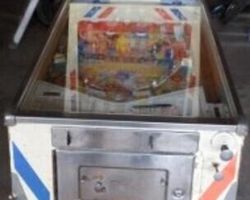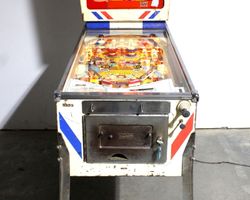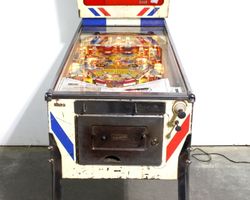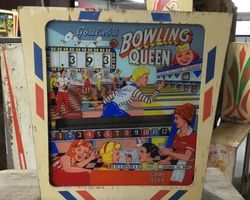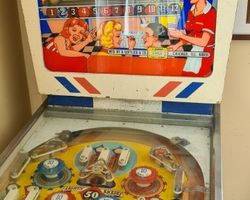Bowling Queen
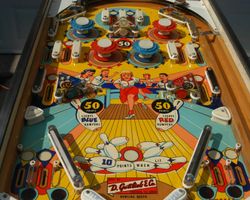
Average Prices: USD $300 to $1,200
Produced: July, 1964
Production Run: 2,650 units
Machine Type: Electro-mechanical
Players: 1
Design by: Wayne Neyens
Art by: Roy Parker
Bowling Queen stands as a definitive electro-mechanical (EM) pinball machine from D. Gottlieb & Co., released in July 1964. The game embraces a popular recreational theme, directly drawing inspiration from the widespread appeal of bowling alleys and the competitive spirit of the sport during the mid-20th century. Its creation was a collaborative effort, with Wayne Neyens handling the machine's core design, concept, animation, and mechanical engineering. The distinct visual style was brought to life by artist Roy Parker, whose work consistently defined the aesthetic of Gottlieb machines of this era.
Released on July 1st, 1964, Bowling Queen was produced as Model Number 212, with a total production run of 2,650 units. This output made it a common sight in arcades and amusement venues of the time. An interesting facet of its design lineage is that Bowling Queen shares its fundamental playfield layout with two other Gottlieb titles: Rack-A-Ball (1962) and Mibs (1969). This shared foundation speaks to the effectiveness and enduring appeal of Wayne Neyens' playfield geometry. The machine itself is a "wedge head" cabinet, a design characteristic of Gottlieb's EM games, and features a mechanical display for scorekeeping, with a maximum displayed score of 1,999 points. Its initial public mention appeared in The Billboard magazine in July 1964, signaling its entry into the market.
Signature Features and Design
A defining characteristic of Bowling Queen is its distinctive mechanical backbox animation. This feature is not merely decorative; it directly integrates into the core gameplay objective. As players progress, miniature bowling balls visually ascend into a "rack" within the backbox. This direct, tangible representation of progress provides immediate feedback, enhancing player engagement beyond merely watching score reels increment.
The backglass artwork, a signature of Roy Parker, is a prominent design element. It portrays the titular "Bowling Queen" alongside onlookers, capturing the mid-century leisure atmosphere. Notably, the backglass also depicts three other Gottlieb pinball machines: Bowling Queen itself, Gaucho, and Flipper Clown. This self-referential detail adds a layer of charm, celebrating Gottlieb's own diverse portfolio. The overall design philosophy emphasizes visual clarity and a direct connection between player action and on-screen (or rather, in-backbox) results, making the game's objective readily apparent.
Playfield and Mechanics
The playfield of Bowling Queen presents a symmetrical layout, a hallmark of Wayne Neyens' design philosophy. It incorporates two flippers at the base, four pop bumpers, two slingshots, and three standup targets. A stationary post is positioned strategically below the flippers to offer a degree of control or redirection, depending on the ball's trajectory.
The core of the playfield design revolves around a system of twelve rollover lanes. These are central to achieving the game's primary objective. The design's cleverness, and indeed its challenge, lies in the placement of these rollovers: four of the twelve are situated in the outlane positions. This arrangement transforms what would typically be a ball-draining event into a potentially rewarding one, requiring players to master the art of skillful nudging and strategic ball control to guide the ball into these difficult-to-reach lanes.
The aesthetic of the playfield is vibrant, leveraging color and lines to guide the player's eye toward the various targets and lanes. Roy Parker's art on the playfield complements the backglass, maintaining a cohesive theme. Lighting is primarily functional, illuminating the rollover lanes as they become active or are hit, clearly indicating progress toward the overarching goal. The combination of its robust mechanical components and thoughtful layout contributes to the machine's reputation for challenging yet rewarding play.
Gameplay Dynamics
The primary objective in Bowling Queen diverges from a sole focus on accumulating high scores. Instead, the game centers on a unique "racking" mechanic: hitting specific lit rollover lanes advances a bowling ball into a visual rack displayed in the backbox. The ultimate goal is to rack all twelve bowling balls. Each successful hit on a lit rollover lane contributes to this progression, making the backbox animation a direct indicator of achievement.
This objective introduces a distinct strategic layer. Since four of the twelve essential rollover lanes are positioned in the outlanes, players are faced with a dilemma. Successfully guiding the ball into an outlane rollover grants progress toward racking all balls but simultaneously risks losing the ball in play. This forces a delicate balance between aggressive play for the main objective and careful ball preservation for score accumulation. The game rewards precise plunging to set up initial shots and highly refined nudging skills to steer the ball into the desired lanes, especially the often-elusive upper rollovers and outlane targets. Players must master the art of coaxing the ball into specific paths, often relying on the ricochet from the four pop bumpers or the two slingshots. The challenge is amplified in a standard three-ball game, where every lost ball significantly impacts the chances of racking all twelve. This makes Bowling Queen a game that prioritizes player skill and control over random chance.
Reception and Legacy
Bowling Queen has garnered a positive reputation within the pinball community, particularly among enthusiasts of electro-mechanical machines from the 1960s. Its primary strength lies in its challenging gameplay, specifically the demanding task of racking all twelve bowling balls in the backbox. This unique "racking" feature is frequently cited as a highlight, providing a distinct and engaging objective that transcends typical high-score chasing. The machine's animated backglass, an embodiment of Wayne Neyens' creativity, is consistently praised as a captivating visual element that directly enhances the gameplay experience. Roy Parker's artwork, both on the backglass and playfield, is also well-regarded for its vibrant aesthetic and its ability to capture the era's charm. Gottlieb's manufacturing quality of the period is evident in Bowling Queen's robust construction, earning it a reputation for durability. The game also stands as a testament to the effectiveness of Wayne Neyens' symmetrical playfield layout, a design so robust it was reused in two other Gottlieb titles, Rack-A-Ball and Mibs.
However, Bowling Queen is not without its noted challenges, which are often perceived as integral to its difficulty rather than design flaws. The combination of small flippers and large slingshots makes ball control a demanding exercise, contributing to a steep learning curve. Players frequently comment on the difficulty of reaching the upper rollover lanes from the flippers, requiring precise shots or strategic nudges. The inherent tension between accumulating points and achieving the primary objective of racking balls (especially given the outlane rollovers) can lead to an ambiguous sense of immediate progression for some players. Despite these aspects, which some might consider limitations, the community largely appreciates Bowling Queen for its demanding nature and its ability to test player skill, particularly nudging proficiency. Its legacy is cemented as a challenging, yet highly rewarding, classic EM pinball machine, embodying Gottlieb's design philosophy of creating games that provided operators with income through their inherent difficulty and replayability.
Sponsored Links
 Ebay Listings
Ebay Listings
 Auction Results
Auction Results
| Cost | Location | Date |
|---|---|---|
| USD $420 |  Wisconsin, United States Wisconsin, United States |
29 October, 2025 |
| USD $550 |  Maryland, United States Maryland, United States |
14 November, 2024 |
| USD $4,495 |  Illinois, United States Illinois, United States |
30 October, 2024 |
| USD $500 |  Maryland, United States Maryland, United States |
09 November, 2023 |
| USD $3,295 |  California, United States California, United States |
25 June, 2023 |
| GBP £1,000 |  Derby, United Kingdom Derby, United Kingdom |
11 March, 2023 |
| AUD $2,600 |  New South Wales, Australia New South Wales, Australia |
02 October, 2022 |
| USD $1,200 |  Wisconsin, United States Wisconsin, United States |
13 August, 2022 |
| GBP £821 |  United Kingdom United Kingdom |
09 August, 2022 |
| USD $1,495 |  Tennessee, United States Tennessee, United States |
13 November, 2021 |


Private Policy · Search Website · Contact Us
As an eBay Partner, we may earn a commission from qualifying purchases made through links on this site, at no additional cost to you.
All trademarks and copyrighted materials remain property of their respective owners. All other content copyright 2007 - 2025 Pinpedia.

